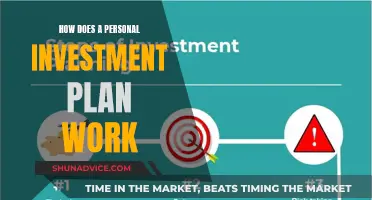
Wine can be a good investment option if you do it right. While you won't receive any interest or dividends, you can expect solid growth if you buy the right wine. The fine wine investment market deals with a tiny proportion of the world's wine (less than 0.1%), and it has its own index, the Live-Ex Fine Wine 100 Index. The majority of investment wines are French and from the Bordeaux region, with around 20% coming from other regions and countries, and most are red.
When it comes to specific wines to invest in, sources suggest a variety of options, including:
- Chateau Lafite-Rothschild
- Giacomo Conterno Barolo Monfortino
- Screaming Eagle
- Chateau Petrus
- Chateau Margaux
- Sassicaia
- Solaia
- Ornellaia
- Penfolds Grange Hermitage
- Ridge, Monte Bello Red
- Guigal, Ermitage, Ex Voto Blanc 2017
- Santa Rita, Casa Real, Maipo Valley, Chile 2018
What You'll Learn

Buy in bulk
Buying in bulk is one of the fundamental rules of investing in wine. It is important to buy wines in quantity, preferably in their original packaging. Full, original cases tend to bring the highest prices over time. Buyers are willing to pay a premium to have a wine in its original packaging, as it creates more confidence in the quality of the collection.
Although loose bottles can also be investment-worthy, original cases are always the best option. The more you are able to buy of any given wine, the more you will be able to sell over time as the market continues to appreciate. It is always smart to have some "loose" bottles for the purpose of declaring dividends by drinking some of the wine from time to time.
It is recommended to buy a full case, whether it is a three-pack, six-pack, or twelve-bottle case. Most investment-worthy wines are bought and sold in cases of 12, so you are generally looking at multiples of thousands of pounds just to start a worthwhile portfolio.
Don't Be Hasty: The Perils of Impulsive Trading
You may want to see also

Store in optimal conditions
Storing your wine in optimal conditions is crucial to maintaining its quality and ensuring it ages gracefully. Here are some key considerations for creating the perfect environment for your investment wines:
Temperature Control: Maintain a consistent temperature in your storage space. The ideal temperature for ageing fine wines is around 55 degrees Fahrenheit (12-13 degrees Celsius). Some experts suggest that even cooler temperatures, in the range of 40-50 degrees Fahrenheit (4-10 degrees Celsius), can be beneficial, as lower temperatures slow down the ageing process, allowing the wines to develop more complex flavours over time.
Humidity Control: Humidity is just as important as temperature when it comes to wine storage. Aim for relative humidity levels of around 70%. This helps prevent corks from drying out and keeps the wine from oxidising too quickly.
Darkness: Keep your wines away from direct sunlight and strong artificial lighting. UV rays can damage wine, causing premature ageing and flavour deterioration. Store your wines in a dark or dimly lit space to avoid these issues.
Ventilation: Good air circulation is essential to prevent mould and odour issues. Ensure your storage area has adequate ventilation to maintain a fresh environment for your wines.
Security: Invest in a secure storage facility with proper alarms and surveillance. Your wines are valuable assets, and it's important to protect them from theft or vandalism.
Bonded Warehouses: Consider using a bonded warehouse for storage. These specialised facilities are designed for storing fine wines and offer optimal temperature, humidity, and security. Additionally, wines stored in bonded warehouses are exempt from VAT, and they provide a professional image that can be reassuring to potential buyers.
By following these guidelines, you can create the optimal conditions to preserve and age your investment wines, ensuring they maintain their value and provide a solid return in the future.
Market Volatility: Navigating the Investment Storm
You may want to see also

Diversify your portfolio
Diversifying your wine portfolio is a great way to spread risk and increase your chances of a good return on investment. While the majority of investment wines are French and from the Bordeaux region, there are other regions and countries that are gaining traction. Here are some tips to diversify your wine portfolio:
Include Wines from Different Regions
Although Bordeaux wines have traditionally dominated the investment scene, wines from other regions are becoming increasingly popular. Burgundy, for example, has enjoyed strong growth over the last five years, and its wines, both red and white, can fetch some of the highest prices ever paid for wine. The Rhone Valley, Tuscany, and the USA (particularly Napa Valley) are also producing wines that are attracting the attention of savvy investors.
Look Beyond the Usual Suspects
While the Grand Cru wines of Bordeaux and Burgundy will always be reliable investments, it's worth considering wines from less obvious regions. For example, the Super Tuscans, including Tignanello, Sassicaia, Solaia, and Ornellaia, have seen significant price increases on secondary markets. Piedmont in Italy is another region to watch, with Barolos and its neighbour Barbaresco producing several investment-grade wines.
Don't Forget the New World
When it comes to investment-worthy New World wines, the USA (specifically California) and Australia are the dominant players. Napa Valley, with its ideal climate and elevation, is home to some of the most sought-after wines, including Screaming Eagle, Schrader Cellars, and Dominus. Australia, meanwhile, has several wines that have consistently increased in value over the past decade, including Penfolds Grange, RWT, Bin 389, and Bin 407, as well as Jim Barry's The Armagh and Henschke's Hill of Grace.
Consider Different Varietals
While red wines, particularly Grand Cru reds, make up the majority of investment wines, there are other varietals that can be worth considering. Sparkling wines and Champagne, for instance, are becoming increasingly popular with collectors. Limited editions from well-known Champagne houses, such as Dom Pérignon, are a good bet, as are prestige cuvées from family-owned producers like Taittinger.
In conclusion, by including wines from different regions, looking beyond the usual suspects, considering New World wines, and thinking beyond red varietals, you can effectively diversify your wine portfolio and increase your chances of a successful investment. Remember to always do your research, buy from reputable dealers, and store your wines correctly to ensure the best possible return.
Shares vs. Mortgage: Where Should Your Money Go?
You may want to see also

Do your research
Wine can be a good investment option if you do it right. However, it's important to note that wine investing is high-risk and subject to large drops in price, so you should be in it for the long term.
Before investing in wine, it's crucial to do your research. Understand the wine rating systems such as Robert Parker's TWA rating system and the Wine Spectator's Scale, both of which are out of 100 points. Websites like Wine Searcher allow you to search live prices for hundreds of different wines across the world.
It's also important to only buy from reputable dealers where you are certain of the wine's provenance. Wine fraud is a real issue, as highlighted by the Netflix documentary *Sour Grapes*.
When it comes to which wines to invest in, the majority of investment-grade wines are French and from the Bordeaux region, with around 20% coming from other regions and countries. Red wines are also the most common investment wines.
If you're looking for specific recommendations, sources suggest wines from the following vineyards:
- Chateau Lafite-Rothschild
- Chateau Latour
- Chateau Margaux
- Chateau Petrus
- Giacomo Conterno (Barolo Monfortino)
- Screaming Eagle (Napa Valley)
- Dominus Estate (Yountville)
- Penfolds Grange Hermitage (Barossa Valley)
- Domaine de la Romanee-Conti
- Chateau Mouton Rothschild
- Domaine Armand Rousseau
- Chateau La Mission Haut Brion
- Domaine du Comte Liger-Belair
- Chateau Cheval Blanc
- Domaine Comte de Vogue
Passive Investing for Beginners: A Guide to Getting Started
You may want to see also

Be in it for the long term
Wine can be a good investment option if you do it right. However, it's important to remember that wine investing is a long-term game. The market can be susceptible to large drops, so you need to be prepared for the long haul. Here are some things to keep in mind when investing in wine for the long term:
Do Your Research
Learn about the different wine rating systems, such as Robert Parker's TWA rating system and the Wine Spectator's Scale. Both use a 100-point scale to evaluate wines. Websites like Wine Searcher allow you to search live prices for hundreds of different wines across the globe. It's crucial to have a good understanding of the market and the wines you're investing in.
Buy from Reputable Dealers
Ensure that you only purchase wines from reputable dealers where you are certain of the wine's provenance. The wine investment market has been plagued by fake wines in the past, as highlighted by the Netflix documentary *Sour Grapes*. It's essential to buy from trusted sources to avoid scams and ensure the quality and authenticity of your investment.
Invest for the Medium to Long Term
Wine investing is not a get-rich-quick scheme. To see returns, you should be prepared to hold onto your wines for at least five years. The recommended holding period for wine investments is typically medium to long term. This allows your wines to age and potentially increase in value over time.
Avoid Buying 'En Primeur'
It's best to avoid buying wine 'en primeur', which means investing in a wine before it's even bottled. This carries additional risks as the wine's quality and market demand cannot be accurately assessed until it's been bottled and released.
Store Your Wines Properly
Proper storage is crucial for maintaining the quality and value of your wine investments. Invest in temperature- and humidity-controlled storage to ensure optimal conditions for your wines. Consider using third-party storage in dedicated bonded warehouses, as this provides ideal conditions and enhances the security of your wines. Additionally, wines stored in bonded warehouses are exempt from VAT, and buyers often prefer wines from these facilities as they are assured of proper storage and authenticity.
Diversify Your Portfolio
When investing in wine, it's essential to diversify your portfolio. While French wines, particularly those from Bordeaux and Burgundy, dominate the investment scene, don't be afraid to explore other regions. Include wines from Champagne, Rhone, Tuscany, and the USA (Napa Valley) in your portfolio. By diversifying, you reduce the risk of your investment and increase your exposure to different markets and consumer preferences.
Investing in Commodities: Why?
You may want to see also
Frequently asked questions
The fine wine investment market deals with a tiny proportion of the world's wine (less than 0.1%). The market has its own index, the Live-Ex Fine Wine 100 Index, which tracks the price of the top wines by demand.
The Grand Cru wines of Bordeaux and Burgundy have long dominated the scene, but wines from other regions are now gaining traction. Popular investment wines include:
- Chateau Lafite-Rothschild
- Chateau Mouton Rothschild
- Chateau Latour
- Giacomo Conterno Barolo Monfortino
- Screaming Eagle
- Penfolds Grange Hermitage
- Santa Rita, Casa Real, Maipo Valley, Chile 2018
Investment wines have built their reputations over decades and will always produce highly rated or scored wines. If an estate has an exceptional year, demand will increase along with the price. They may also hit a production problem, limiting the supply to the market, which is good for investors.
Wine investing is about doing your research. Learn about the wine rating systems such as Robert Parker's TWA rating system and the Wine Spectator's Scale, both out of 100 points. Only buy from reputable dealers where you are sure of the provenance. Invest for the medium to long term to ensure you get a return—a minimum of five years is recommended.
Investment wines need to be kept in third-party storage in dedicated bonded warehouses, not in your own cellar or kitchen. Bonded wine cellars are kept at perfect temperatures and humidity, run by professionals, and are highly secure. Wines bought as an investment and stored in a bonded warehouse are exempt from VAT.







